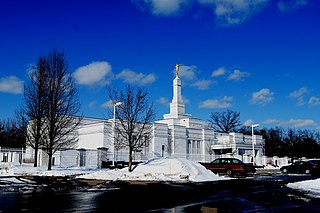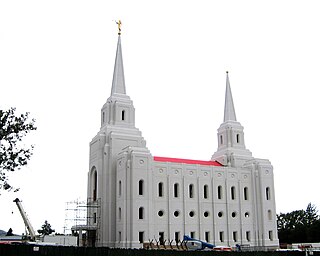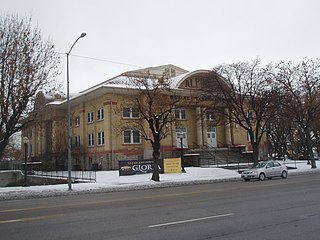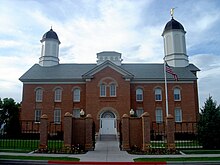
The Ogden Utah Temple is the sixteenth constructed and fourteenth operating temple of the Church of Jesus Christ of Latter-day Saints. Located in Ogden, Utah, it was originally built with a modern, single-spire design very similar to the Provo Utah Temple. During a renovation completed in 2014, the exterior and interior were extensively changed.

The Detroit Michigan Temple is the 63rd operating temple of the Church of Jesus Christ of Latter-day Saints. It is located in Bloomfield Hills, a suburb of Detroit.

The Mount Timpanogos Utah Temple is the 49th operating temple of the Church of Jesus Christ of Latter-day Saints. The temple is located in American Fork, Utah and is the second temple built in Utah County and the ninth in Utah.

The Draper Utah Temple is the 129th temple of the Church of Jesus Christ of Latter-day Saints. It was dedicated in sessions from March 20–22, 2009. Prior to the dedication, the temple was open to the public from January 15, 2009 through March 14, 2009.

On December 27, 1832, two years after the organization of the Church of Christ, the movement's founder, Joseph Smith, stated he received a revelation that called upon church members to restore the practice of temple worship. The Latter Day Saints in Kirtland, Ohio were commanded to:
"Establish a house, even a house of prayer, a house of fasting, a house of faith, a house of learning, a house of glory, a house of order, a house of God."

The Oquirrh Mountain Utah Temple is a temple of the Church of Jesus Christ of Latter-day Saints located in South Jordan, Utah, a suburb of Salt Lake City. South Jordan was the first city in the world to have two temples. The temple was the fourth in the Salt Lake Valley and the 13th in the state of Utah.

The Church of Jesus Christ of Latter-day Saints was established in the Hawaiian Islands in 1850, 11 years after the Edict of Toleration was decreed by Kamehameha III, giving the underground Hawaii Catholic Church the right to worship, and at the same time allowing other faith traditions to begin establishing themselves.

The Church of Jesus Christ of Latter-day Saints in Utah refers to the Church of Jesus Christ of Latter-day Saints and its members in Utah. Utah has more church members than any other U.S. state or country. The LDS Church is also the largest denomination in Utah.

The Brigham City Utah Temple is a temple of the Church of Jesus Christ of Latter-day Saints in Brigham City, Utah. The temple was announced by church president Thomas S. Monson on October 3, 2009, during the church's general conference. The temple was announced concurrently with those to be constructed in Concepción, Chile, Fort Lauderdale, Florida, Fortaleza, Brazil and Sapporo, Japan; at the time, the announcement brought the total number of temples worldwide to 151. It is the fourteenth temple of the LDS Church completed in Utah.

The Church of Jesus Christ of Latter-day Saints in Oregon refers to the Church of Jesus Christ of Latter-day Saints and its members in Oregon. Oregon has the 9th most members of the church of any U.S. state. Members have had considerable influence in the state throughout its contemporary history and many influential Latter-day Saints have come from Oregon, including Senator Gordon H. Smith.

The Provo Tabernacle was a tabernacle of the Church of Jesus Christ of Latter-day Saints from 1898 to 2010 in downtown Provo, Utah, United States. It was a historic icon of Provo and had been home to many religious and cultural events. All but the outer walls of the building were destroyed by fire in December 2010. The LDS Church preserved the remaining outer walls and built a new foundation and interior as part of the Provo City Center Temple, completed in 2016.

In the Church of Jesus Christ of Latter-day Saints, a tabernacle is a multipurpose religious building, used for church services and conferences, and as community centers. Tabernacles were typically built as endeavors of multiple congregations, usually at the stake level. They differ from meetinghouses in scale and differ from temples in purpose.

The Provo City Center Temple is a temple of the Church of Jesus Christ of Latter-day Saints on the same site as the former Provo Tabernacle in Provo, Utah. Completed in 2016, the temple utilizes much of the external shell of the tabernacle, all that remained of the original building after a fire in December 2010.

The Bear Lake Stake Tabernacle, or Paris Tabernacle is situated on main street in Paris, Idaho, is a Romanesque red sandstone meetinghouse of the Church of Jesus Christ of Latter-day Saints designed by Joseph Don Carlos Young, the son of Brigham Young built between 1884 and 1889. The tabernacle was built by Mormon pioneers of Bear Lake Valley who used horse and ox teams to haul rock quarried from Indian Creek Canyon nearly 18 miles away. After the completion of the Logan Utah Temple in 1884, the workers began construction of the tabernacle. William Budge supervised the construction. It cost $50,000 to build and seats around 2000 people.

The Alpine Stake Tabernacle or Alpine Tabernacle, located at 110 East Main Street (US-89) in American Fork, Utah, United States, functions as a meeting place for large gatherings of members of the Church of Jesus Christ of Latter-day Saints in northern Utah County for worship services. The building is part of the American Fork Historic District listed on the National Register of Historic Places.

The Granite Stake Tabernacle is a tabernacle of the Church of Jesus Christ of Latter-day Saints in the Sugar House District of Salt Lake City, Utah, United States. It has historic significance to the area and was listed in the U.S. National Register of Historic Places in 2003.

The Weber Stake Tabernacle, later known as the Ogden Pioneer Tabernacle, was a tabernacle belonging to the Church of Jesus Christ of Latter-day Saints. The tabernacle was constructed by Latter-day Saints in Ogden, Utah during the 1850s. The building stood for over one-hundred years, until it was razed in 1971 to make way for the Ogden Utah Temple.

The Lehi Tabernacle served as a tabernacle of The Church of Jesus Christ of Latter-day Saints from its 1910 dedication to 1920 when it was sold to the Alpine School District. The building was reestablished as a tabernacle in 1937 until its eventual 1962 demolition in downtown Lehi, Utah, United States.

The Taylorsville Utah Temple is a temple awaiting dedication of the Church of Jesus Christ of Latter-day Saints in Taylorsville, Utah. Plans to construct the temple were announced on October 5, 2019 by church president Russell M. Nelson, during the church's general conference. The temple is the first in the city of Taylorsville, the fifth in Salt Lake County, and the twenty-third in the state of Utah.
The architecture of the Church of Jesus Christ of Latter-day Saints includes the design and use of the church's temples, meetinghouses, historic sites, and other buildings and facilities. The LDS Church is known for its unique and often imposing architecture. The church's architecture differs based on the uses of individual buildings and varies in style throughout the world.























